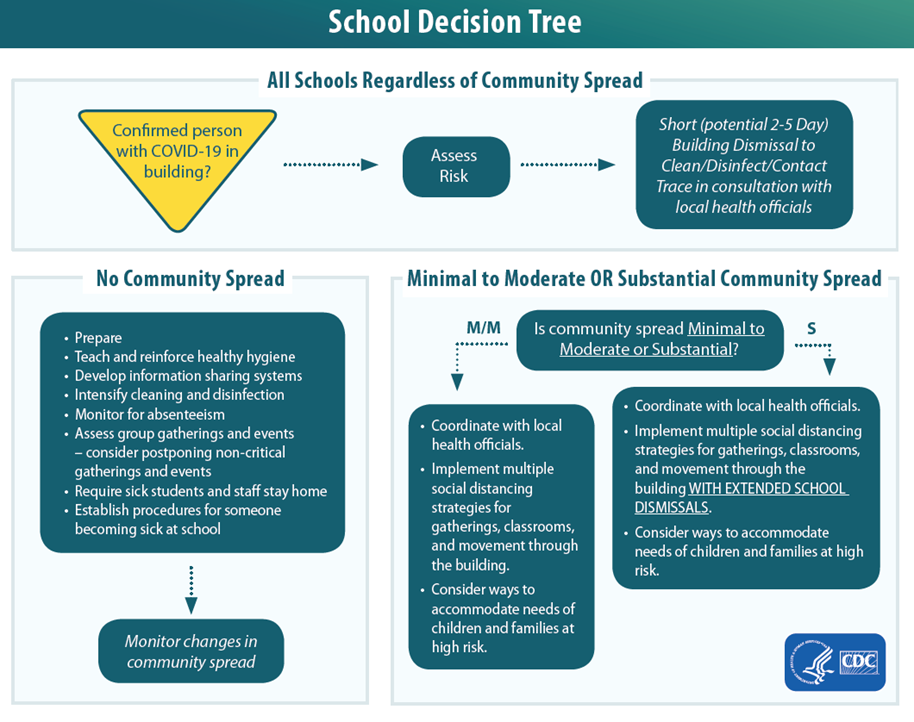As of Monday, March 16, 2019, many public and private schools across the nation have closed. And the situation is continuing to change. School closures, self-quarantine, social distancing, and tough decisions, including canceled meetings and other in-person events, have become essential to help 'flatten the curve,' slowing the spread of Coronavirus (COVID-19) and ensuring that key healthcare facilities do not become overburdened. While these are not the easiest decisions, they can help slow down the spread of Coronavirus (COVID-19).
Protecting Students and Staff: Proactive measures that all K12 Schools and Universities can implement to help mitigate the spread of Coronavirus (COVID-19)
 The health and safety of all students and staff is always a top priority for K12 Schools, Colleges, and Universities, and it is now more than ever in the wake of the evolving global situation around the novel coronavirus (COVID-19). We encourage everyone to listen to facts and not respond to fear, and we have provided a list of resources at the end of this article.
The health and safety of all students and staff is always a top priority for K12 Schools, Colleges, and Universities, and it is now more than ever in the wake of the evolving global situation around the novel coronavirus (COVID-19). We encourage everyone to listen to facts and not respond to fear, and we have provided a list of resources at the end of this article.
How to create an emergency response management plan?
Maintaining the health and safety of educational facilities falls into the realm of facilities managers and directors. COVID-19 is a fluid situation that requires agility and proactive measures. In light of the current situation, we have rounded up a list of proactive measures that K12 Schools and Universities can take to protect students and staff.
Read our guide to emergency response management and preparedness for facility managers.
The Centers for Disease Control (CDC) has released updated guidelines for US 12 schools and childcare program administrators to appropriately plan, prepare, and respond to Coronavirus (COVID-19).
While decisions about implementing school-based strategies (e.g., dismissals, event cancellations, other social distancing measures) will be made locally, in collaboration with local health officials who can help determine the level of transmission in the community, the CDC has released a comprehensive decision tree to help schools determine which set of mitigation strategies may be most appropriate for their current situation.

Further to this, there are several proactive measures that all facilities professionals can implement to help mitigate the spread of coronavirus (COVID-19):
- Making hand sanitizer available in all common areas, such as bathrooms, lobbies, and check-in areas.
- Enhanced cleaning and sanitizing of all buildings, including all common areas and individual spaces.
- Increase the frequency and scope of cleaning frequently touched surfaces throughout the workplace, including disinfectants on all high-traffic areas, such as door handles, elevator call buttons, and faucets.
- Coordinate with building Engineers to increase the fresh air balance of HVAC systems.
- Posting informative guides on proper hand-washing to ensure sanitization.
- Maintaining continuous and accurate communication on additional measures that need to be implemented during this dynamic situation.
For those K12 Schools and Universities that remain open, continue promoting everyday disease prevention strategies:
- If you are sick, stay home from school.
- Avoid close contact with those who are already sick.
- Cover your nose and mouth when coughing or sneezing with a tissue or the crook of your arm.
- Wash your hands often with soap and water.
- Avoid touching the eyes, nose, or mouth.
- Consult this web page for further guidance from the U.S. Department of Education.
Schools can share relevant CDC fact sheets to help students, families, and staff understand COVID-19, along with steps they can take to protect themselves:
- What you need to know about coronavirus disease 2019 (COVID-19)
- What to do if you are sick
- Stop the spread of germs – help prevent the spread of respiratory viruses like COVID-19
The bottom line: People should help each other but listen to public health experts’ guidelines at the same time—implement social distancing, resist the urge to shake hands, and, above all, don’t go out if you’re sick.
From all of us at Intellis, Be well!

